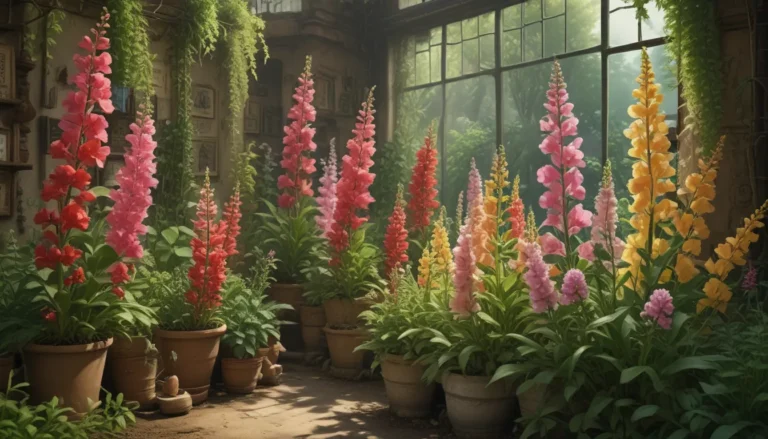A Complete Guide to Growing Tropical Nepenthes Pitcher Plants Indoors

If you’re looking for a unique plant to bring into your home that goes beyond just aesthetic beauty, tropical pitcher plants from the Nepenthes genus may be just what you’re looking for. These intriguing plants, also known as “monkey cups” or “monkey jars,” are not only visually appealing but also have a fascinating predatory nature that sets them apart from your average houseplant.
In this comprehensive guide, we will explore everything you need to know about growing tropical Nepenthes pitcher plants indoors. From understanding the different species to creating the ideal growing conditions, propagation, pruning, maintenance, and managing pests and diseases, we’ve got you covered. Let’s dive in and discover how you can successfully care for these captivating plants in your home.
Understanding Nepenthes Pitcher Plants
Tropical pitcher plants from the Nepenthes genus are primarily native to Southeast Asia, Madagascar, and Australia. They are carnivorous perennials that thrive in warm, humid environments. These plants are characterized by their unique pitchers, which contain digestive fluid used to trap and consume their prey. While their diet primarily consists of insects, some larger species have been known to capture rodents, lizards, and even birds.
One interesting feature of Nepenthes pitcher plants is that they produce two types of traps – ground pitchers and aerial pitchers. Ground pitchers are typically found near the base of the plant, while aerial pitchers grow on climbing stems.
When it comes to caring for Nepenthes pitcher plants, it’s essential to understand that their needs vary depending on the species and their natural habitat. Highland and lowland species have distinct requirements, and it’s crucial to provide the right conditions for each type to ensure their health and vitality.
Recommended Growing Conditions
Creating the ideal growing conditions for tropical Nepenthes pitcher plants involves a careful balance of several key factors. Here are some essential elements to consider when caring for these unique plants:
Airflow
- Proper air circulation is crucial to prevent the buildup of humidity and prevent diseases.
- Ensure adequate ventilation to support healthy growth.
Soil
- Use a specific potting mix designed for Nepenthes plants or create a blend of sphagnum moss, perlite, and orchid bark for optimal drainage.
- Avoid using regular potting soil, as it can be too dense and hold excess moisture.
Sunlight
- Provide bright, indirect light for Nepenthes plants, mimicking their natural habitat under the forest canopy.
- Avoid direct sunlight, especially during the hottest parts of the day.
Water
- Use distilled water or rainwater to avoid introducing harmful minerals and nutrients.
- Keep the substrate slightly damp to the touch to ensure proper hydration.
By paying attention to these essential growing conditions, you can create a suitable environment for your tropical Nepenthes pitcher plants to thrive.
Highland Species
- Highland species prefer cooler temperatures and high humidity levels.
- Keep daytime temperatures between 70-85°F and nighttime temperatures between 55-60°F.
- Provide ample airflow and humidity to mimic their misty mountain forest habitat.
Lowland Species
- Lowland species thrive in warmer conditions with high humidity.
- Maintain temperatures between 75-90°F and provide additional humidity if needed.
- Create a steamy jungle-like environment to support these tropical plants.
Container Selection
When choosing a container for your tropical Nepenthes pitcher plants, consider their unique growth habits and root structures. These plants do not have deep roots, making them suitable for various planting options, including pots, terrariums, or kokedama balls.
- Consider using a container with proper drainage to prevent waterlogging.
- Avoid unglazed ceramic pots that may contain salts harmful to the plants.
- Provide support for climbing varieties, such as moss poles or hanging containers.
Propagation
Whether you’re starting with a mature plant or looking to propagate new ones, there are several methods you can use to grow Nepenthes pitcher plants:
From Cuttings
- Select healthy stem cuttings and root them in a suitable potting mix.
- Maintain adequate moisture and humidity to encourage root development.
- Once roots have developed, transplant the cutting into a larger container for optimal growth.
Transplanting
- When transplanting your Nepenthes plants, use a well-draining potting mix to prevent root rot.
- Avoid overwatering and ensure the plant’s roots have plenty of oxygen.
- Monitor the plant’s growth and repot as needed to provide ample space for healthy development.
By following these propagation techniques, you can expand your collection of tropical Nepenthes pitcher plants and enjoy the rewarding experience of growing these unique carnivorous species.
How to Grow
To ensure the healthy growth of your tropical Nepenthes pitcher plants, follow these tips and best practices:
- Provide 8-12 hours of indirect sunlight per day or supplement with a grow light.
- Use distilled water to avoid mineral buildup and maintain optimal hydration levels.
- Create a warm, humid environment similar to their natural habitat for optimal growth.
- Feed your plants with small insects such as mealworms or crickets to supplement their nutrient needs.
By incorporating these growing tips into your care routine, you can encourage robust growth and vibrant pitchers in your tropical Nepenthes plants.
Pruning and Maintenance
Proper pruning and maintenance are essential to keep your tropical Nepenthes pitcher plants healthy and thriving. Follow these guidelines to care for your plants effectively:
- Trim back vines to encourage bushier growth and prevent excessive elongation.
- Remove wilted or diseased leaves and pitchers to maintain plant health.
- Check the soil regularly for signs of decomposition and repot as needed.
- Monitor the plant’s overall health and address any issues promptly to prevent disease spread.
By staying proactive with pruning and maintenance tasks, you can promote the long-term health and vitality of your tropical Nepenthes pitcher plants.
Species and Cultivars to Select
When choosing a specific Nepenthes species or cultivar for your indoor collection, consider factors such as ease of care and suitability for your growing conditions. Here are a few popular options that are well-suited for indoor cultivation:
Alata
- Beginner-friendly lowland species with large, colorful pitchers.
- Ideal for direct morning sunlight and relatively easy to grow indoors.
Ampullaria
- Feeds on detritus rather than live prey, making it low-maintenance and suitable for terrarium settings.
- Grows in clusters along the jungle floor with open-mouthed pitchers.
Bill Bailey
- Hardy hybrid cultivar with compact size and vibrant pitchers.
- Suitable for intermediate growing conditions between highland and lowland preferences.
Diana
- Easy-care cultivar with compact cluster growth and colorful pitchers.
- Ideal for beginners and well-suited for indoor cultivation.
Sanguinea
- Commonly chosen species for indoor growing, known for its vibrant pitchers and hardiness.
- Requires regular feeding with live insects to thrive indoors.
- Selecting the right species and cultivars based on your experience level and growing conditions can help you create a successful tropical Nepenthes pitcher plant collection in your home.
Managing Pests and Disease
While Nepenthes pitcher plants are generally resistant to pests, occasional infestations may occur. Keep an eye out for common pests such as aphids, fungus gnats, and spider mites, and address them promptly to prevent damage to your plants.
Diseases such as Botrytis and Cercospora leaf spot can affect Nepenthes plants if not properly managed. Ensure your plants receive adequate airflow and avoid overwatering to prevent fungal infections.
By maintaining proper growing conditions and monitoring your plants regularly, you can minimize the risk of pests and diseases and promote the overall health of your tropical Nepenthes pitcher plants.
In Conclusion
Growing tropical Nepenthes pitcher plants indoors can be a rewarding experience for plant enthusiasts looking to add a unique and captivating species to their collection. By understanding the specific requirements of these carnivorous plants, creating the ideal growing conditions, and following proper care practices, you can successfully cultivate healthy and vibrant Nepenthes pitcher plants in your home.
Whether you’re a beginner looking to start your Nepenthes journey or an experienced grower seeking to expand your collection, these fascinating plants offer a captivating glimpse into the world of carnivorous species. With the right knowledge and care, you can enjoy the beauty and intrigue of tropical pitcher plants thriving in your indoor environment.
We hope this comprehensive guide has provided you with valuable information and insights into growing tropical Nepenthes pitcher plants indoors. If you have any questions or would like to share your experiences with these unique plants, feel free to leave a comment below. Happy growing!
Remember: with a little knowledge, care, and patience, you can create a jungle paradise right in your own home with tropical Nepenthes pitcher plants.
Disclaimer: This article is for educational purposes only and does not constitute medical advice. Please consult with a qualified horticultural professional or botanist for personalized recommendations.





